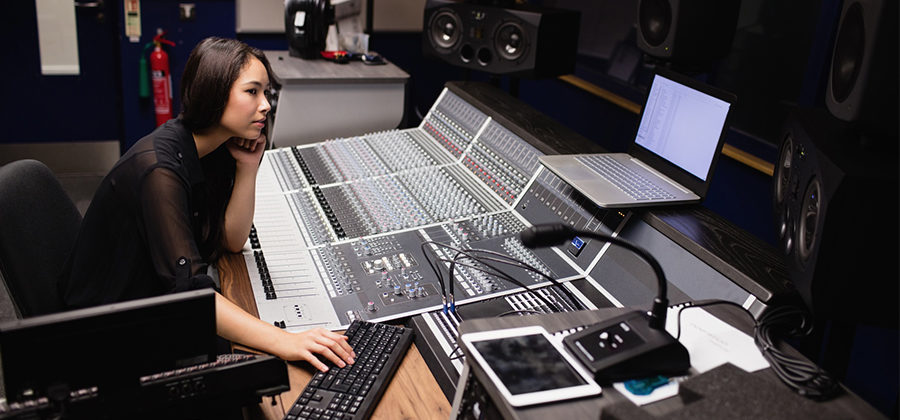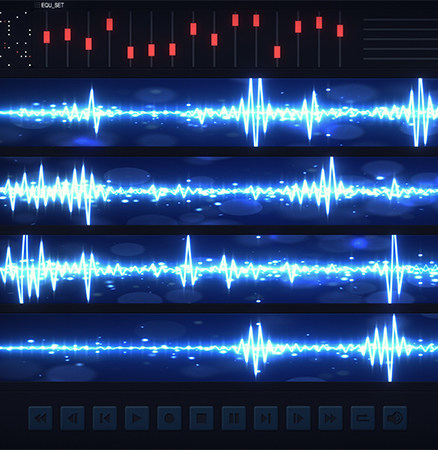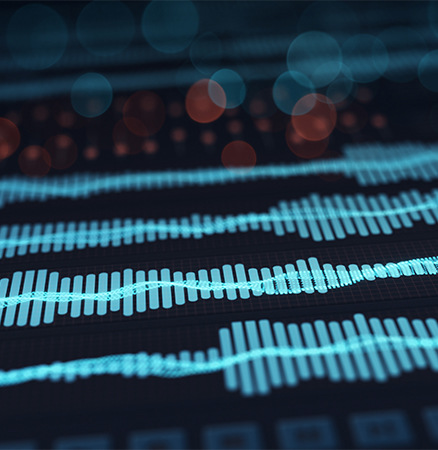The best audio format types for audiophiles.
Don’t let the choices overwhelm you. Whether you’re just listening or you’re mixing and mastering, find the audio file format that fits your needs.

The basics of sound quality.
Audio codecs are programs that compress data for transmission and decompress that data on the receiving end. Their speed is measured in thousands of bits processed per second, known as “bitrate” or “kbps” and this number varies even within a single format. Generally, a lower bitrate means a smaller file, but that also means more data (sound) is lost in compression.
Other important factors are sample rate and bit depth. The sample rate is the number of samples (of signal amplitude or “sound”) per second. Bit depth refers to the number of bits per sample — the higher this number, the fuller (and potentially louder) the sound.



Lossy formats.
Lossy audio formats lose data in the transmission. They don’t decompress back to their original file size, so they end up smaller and some sound waves are lost. Artists and engineers who send audio files back and forth prefer not to use lossy formats, because the files degrade every time they’re exported.
MP3
MP3 (MPEG-1 Audio Layer III) is the most popular of the lossy formats. MP3 files work on most devices and the files can be as small as one-tenth the size of lossless files. MP3 is fine for the consumer, since most of the sound it drops is inaudible, but that’s not the case when it comes to bit depth. “MP3 files can only be up to 16-bit, which is not what you want to be working in,” says producer, mixer and engineer Gus Berry. “You want to be working in at least 24-bit or higher when recording and mixing.”
AAC
Advanced Audio Coding or AAC files (also known as MPEG-4 AAC), take up very little space and are good for streaming, especially over mobile devices. Requiring less than 1 MB per minute of music and sounding better than MP3 at the same bitrate, the AAC format is used by iTunes/Apple Music, YouTube and Android.
Ogg Vorbis
Ogg Vorbis is the free, open-source audio codec that Spotify uses. It’s great for streaming, but the compression results in some data loss. Experts consider it a more efficient format than MP3, with better sound at the same bitrate.
Lossless formats.
These files decompress back to their original size, keeping sound quality intact. Audio professionals want all of the original sound waves, so they prefer lossless. These files can be several times larger than MP3s. Lossless bitrates depend on the volume and density of the music, rather than the quality of the audio.
FLAC
Free Lossless Audio Codec offers lossless compression and it’s free and open-source.
ALAC
Apple’s Lossless Audio Codec allows for lossless compression, but it works only on Apple devices.
Uncompressed formats.
These files remain the same size from origin to destination.
WAV
WAV (Waveform Audio File) retains all the original data, which makes it the ideal format for sound engineers. “WAV has greater dynamic range and greater bit depth,” creative producer and sound mixer Lo Boutillette says of her preferred format. “It’s the highest quality,” Berry agrees. “It can be 24-bit, 32-bit, all the way up to 192kHz sample rate and even higher these days.” If you’re collaborating and sending files back and forth, WAV holds its time code. This can be especially useful for video projects in which exact synchronisation is important.
AIFF
Originally created by Apple, AIFF (Audio Interchange File Format) files are like WAV files in that they retain all of the original sound and take up more space than MP3s. They can play on Macs and PCs, but they don’t hold time codes, so they’re not as useful for editing and mixing.
DSD
Direct Stream Digital is an uncompressed, high-resolution audio format. These files encode sound using pulse-density modulation. They are very large, with a sample rate as much as 64 times that of a regular audio CD, so they require top-of-the-line audio systems.
PCM
Pulse-Code Modulation, used for CDs and DVDs, captures analogue waveforms and turns them into digital bits. Until DSD, this was thought to be the closest you could get to capturing complete analogue audio quality.
A coda on digital audio formats.
If you’re listening to spoken word recordings or you’re a casual listener who’s OK with unoptimised music files, you can go with a compressed format and save space in your music library. If you have more educated ears and expensive audio equipment, you may want lossless compression for its combined space-saving and fidelity. If you’re recording or manipulating audio or setting it to video, always go with lossless or uncompressed. No matter your needs, there’s an audio file format for you.
Contributors
Do more with Adobe Audition.
Your pro workstation for recording and mixing audio, creating podcasts and designing sound effects.
You might also be interested in…
Learn how to create a shot list that guides the crew through all of the day’s camera set-up.
Establishing shots are crucial because they tell us where and often when, the action is happening.
Lossy or lossless? Compressed or uncompressed? Find the audio format that fits your needs.
Learn about the dynamic range of your camera and how to manipulate it to create the images you want.
Get Adobe Audition.
Create, mix and design sound effects with the industry’s best digital audio editing software.
7 days free, then NZ$44.51/mo incl. GST.



